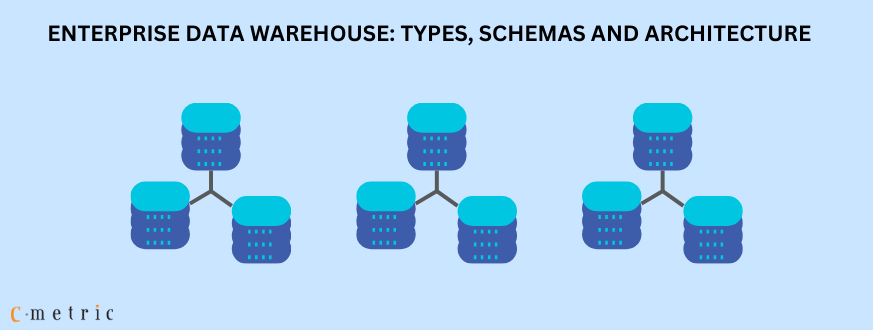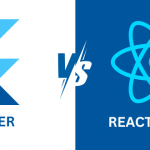To stay competitive, modern businesses should be adaptive to make informed decisions based on facts rather than intuitions. However, crucial business data is often distributed across different departments and handled by disparate teams. This leads to siloed thinking and holds back leaders from getting a holistic view of the organization.
Here’s what this situation could look like The sales team manages data related to customer relationships, sales outcomes, and more. The support team has the customer satisfaction data. Procurement holds information about supply chain management and so on.
The ultimate aim is to have a single, reliable source of information. You need a solution that supports data-driven decisions and provides quicker insights to achieve this. Additionally, data should be gathered from various sources for centralized analysis and business intelligence. This is where an enterprise data warehouse (EDW) comes into the picture.
What is an Enterprise Data Warehouse?
The enterprise data warehouse is defined as the central data repository that stores data from multiple departments, sources, and applications to access and analyze the information. EDW enables data analytics to collect and aggregate data from multiple sources for actionable insights.
EWD or Enterprise Data Warehousing are the same as data warehouses but are larger in size and scope. While data warehouses are designed to handle data from specific departments, EDWs will store data from different departments like finance, CRM, inventory, accounting, and so on.
Types of Enterprise Data Warehouse
Organizations can set up their data warehouses in three key settings.
On-Premises Data Warehouse
On-premise data warehouses are deployed in a physical location, and the organization is in charge of purchasing, implementing, upgrading, and maintaining the complete infrastructure. In this setting, storage devices like hard disks, pen drives, tape storage, or network-attached storage are used to store the data.
While these types of warehouses are great for full control over data storage, they are often expensive as enterprises have to purchase all the required software and hardware. Usually, on-premise data warehouses are hard to scale.
Cloud Data Warehouse
A cloud-based data warehouse is the go-to option for anyone who needs to have data storage that is easy to customize, manage, and scale. Enterprises hire a cloud data warehouse service provider and enjoy need-based databases that are deployed on the cloud. As cloud data warehouses are not attached to a specific location, enterprises can access them anytime and from anywhere. Organizations are allowed to pay for preferred subscriptions and scale the features as and when required.
Hybrid Data Warehouse
A hybrid data warehouse is like having the best of both worlds. You can retain complete control over some important components while outsourcing the other parts. Here’s why it’s a smart choice. A hybrid data warehouse provides flexibility to have complete control over confidential business data. It also provides easy adoption; you are not required to move all your data to a cloud platform at once.
Enterprise Data Warehouse Schemas
In a data warehouse, schema is used to set up relationships between different datasets of a data warehouse. Here are the key kinds of schemas used in EDW.
Star schema
This schema is the most traditional data warehouse building method, including dimension tables and facts. This is an easy-to-design schema with fewer complexities. However, it has less flexibility and chances of high data redundancy.
Snowflake schema
An updated version of the star schema, the snowflake scheme features fact tables and split dimension tables. As a single-dimension table is broken into multiple-dimension tables, the data redundancy odds are lower in this type of scheme. However, it’s complex to design.
Data vault
This is a hybrid approach designed to take the star scheme and third normal form schema into context. A modern-day data vault features raw and business vaults to store raw and business rules.
This schema is preferred in the current enterprise landscape because of the data source addition and deletion flexibility it proffers. It supports quick ETL process automation. But it’s not a perfect pick if you’re dealing with static data.
Components Of An Enterprise Data Warehouse
Types of Enterprise Data Warehouse Architecture
At the very basic level, EDW is a part of the BI solution and can be formed using the below-mentioned architecture types.
Basic Architecture
The very customary architecture for EDWs features data source and data warehouse software. Enterprises simply configure a straightforward data flow setup between a data source and a data warehouse.
Architecture Featuring a Staging Area
This EDW architecture allows enterprises to set up ETL – extract, transform, and load logic using a staging area. The job of this staging area is to clean and transform the data so that it becomes fit for your targeted data warehouses.
Architecture Features a Staging Area and Data Marts
In this architecture type, enterprises build data marts on top of the concerned warehouse and ease down the process of accessing only the required datasets. In this architecture type, three layers are present.
- The ingestion layer is a staging area and is used to prepare the data
- The storage layer features a data warehouse and data marts that store the data in right places
- The presentation layer consists of BI tools and web services that are required to visualize, analyze, and view the data.
How to Build an Enterprise Data Warehouse
Building an enterprise data warehouse is a gradual process that needs a strategic approach to avoid pitfalls. Here is how you can build a data warehouse from scratch.
Step 1 – Define Your Requirement
Start the process by identifying and defining the key requirements related to EDW. Take note of aspects like what type of data warehouse you need, how frequently you need the scalability, the data access control you need to use, and so on.
Step 2 – Understand Data Sources
You need to find reliable data sources to furnish data into the warehouses. You need to define all data supply sources and ensure that unwanted datasets are not part of data warehouses.
Step 3 – Build Data Models
Once these two aspects are sorted, you need to design the warehouse models like conceptual, logical, and physical models. These models are crucial to visualize key business processes and how they communicate with each other.
Step 4 – Recognize and Construct a Schema
Take the help of software architecture to establish relevant data schema from options like the star schema, snowflake schema, and data vault schema.
Once an appropriate data warehouse schema is finalized, you need to construct a data warehouse architecture according to your specified needs.
Final Say
To sum it up, an enterprise data warehouse (EDW) is a critical tool for businesses wanting to make the most of their data. It helps organizations gather data from different sources and create a central place for analysis. This makes it easier for them to make informed choices, find new opportunities, and stay competitive. Building an EDW takes some careful planning and effort, but the advantages are worth it. It can set the stage for a culture where decisions are based on facts, not guesses. An EDW is a wise investment with better flexibility, consistent data, and improved efficiency. It lets you handle your data effectively and always have data ready for analysis.
As data grows, an enterprise data warehouse will probably become crucial for any modern business. By investing in batch-to-real-time data warehousing, our cloud computing experts will help you deliver customized EDW solutions to meet strategic business goals.














